F
False God of Chance, the
One evolutionist claim demolished by 20th-century science is that of chance. Research conducted since the 1960s has revealed that all the physical balances in the universe have been delicately regulated for human life. All the physical, chemical and biological laws in the universe, basic forces such as electromagnetism, and the structures of the atom and the elements have all been regulated in such a way as to make human life possible. Western scientists today call this extraordinary creation the Anthropic Principle. In other words, every detail in the universe possesses a special creation that enables human life. (See Anthropic Principle, the.)
The sudden emergence of a complex structure is very definitely not anything that can be explained in terms of chance. For example, if you see a brand-new make of car among the trees in a forest, you will not imagine that various elements combined to produce it over the course of millions of years. All the raw materials in a car, such as iron, plastic and rubber, either come directly from the Earth or are products of it. Yet this does not imply that these substances were randomly synthesized and then combined to produce a car.
Any rational, logical person will naturally realize that the car was designed by intelligent humans and constructed in a factory, and will wonder what it is doing in a forest. Because the sudden emergence of a fully-formed complex structure shows that it was brought into existence by a conscious will. A system as complex as the cell is of course the product of a sublime knowledge and will—in other words, it was created by our Almighty Lord, God.
Evolutionists believe that coincidences can give rise to flawless structures, though here they part ways with reason and logic. The famous French zoologist Pierre Grassé, formerly president of the French Academy of Sciences, is also a materialist, but maintains that Darwinist theory cannot account for life. He says this about the logic of coincidence that represents the foundation of Darwinism:
The opportune appearance of mutations permitting animals and plants to meet their needs seems hard to believe. Yet the Darwinian theory is even more demanding: a single plant, a single animal would require thousands and thousands of lucky, appropriate events. Thus, miracles would become the rule: events with an infinitesimal probability could not fail to occur. . . There is no law against day dreaming, but science must not indulge in it.160
Grassé goes on to summarize what the concept of coincidence means for evolutionists:
. . . chance becomes a sort of providence, which, under the cover of atheism, is not named but which is secretly worshipped. 161
Feathered Dinosaur Deception, the
With every new fossil discovery, evolutionists engage in speculation on the link between birds and dinosaurs. However, detailed analyses constantly refute the conjecture that these fossils constitute evidence for reptile-to-bird evolution.
A report titled “Feathered Dinosaur Fossils Unearthed in China” in National Geographic magazine in 1996 was thought to represent definitive proof of evolution. But there was an error and a lack of knowledge here. Since there is no evidence that feathered dinosaurs evolved, the report concerning them later proved fictitious.
The article dealt with three theropod dinosaur fossils discovered in China. Great media propaganda sought to portray these as important evidence for evolution. Even in Turkey, certain media organizations devoted wide space to those specious claims.
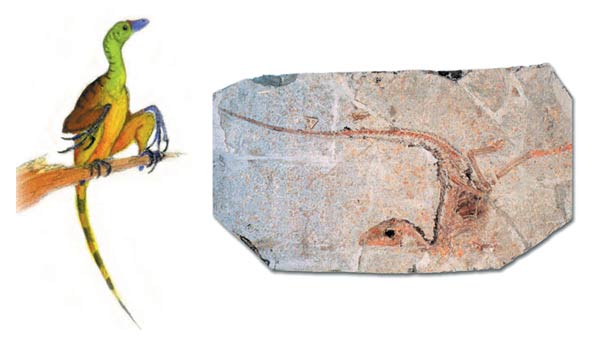 |
| Sinornithosaurus Evolutionist paleontologists claimed this fossil was a feathered dinosaur, but later it was determined that the creature did not possess such a characteristic. |
The fossils described in the National Geographic article are:
1. Archæoraptor
2. Sinornithosaurus
3. Beipiaosaurus
According to the information provided in National Geographic, all three fossils are around 120 million years old, and members of the theropod dinosaur class. (A theropod is the name given to such carnivorous dinosaur species as Tyrannosaurus rex and Velociraptor.) However, National Geographic also maintained that these dinosaurs had bird-like characteristics. These fossil dinosaurs were covered in feathers, similar to those in birds.
Over the months that followed, however, detailed analysis of the fossil known as Sinosauropteryx showed that the structures evolutionists had described as bird feathers were in fact nothing of the sort. An article in Science magazine called “Plucking the Feathered Dinosaur” stated that the structures evolutionist paleontologists portrayed as feathers actually had nothing to do with feathers at all:
Exactly 1 year ago, paleontologists were abuzz about photos of a so-called "feathered dinosaur." . . The Sinosauropteryx specimen from the Yixian Formation in China made the front page of The New York Times, and was viewed by some as confirming the dinosaurian origins of birds. But at this year's vertebrate paleontology meeting in Chicago late last month, the verdict was a bit different: The structures are not modern feathers, say the roughly half-dozen Western paleontologists who have seen the specimens. . . . .Paleontologist Larry Martin of Kansas University, Lawrence, thinks the structures are frayed collagenous fibers beneath the skin—and so have nothing to do with birds. 162
Following the failure of their speculation with regard to Sinosauropteryx, evolutionists moved their attention to new fossil discoveries known as Archæoraptor, Sinornithosaurus and Beipiaosaurus. (See Archaeoraptor). A dogmatic approach to evolution, a lack of thought and belief in a preconception lead to such errors and erroneous interpretations. The fossils in question establish no connection between birds and dinosaurs, but rather raise a number of inconsistencies and contradictions, some of which may be summed up as follows:
The fossils discovered in China and known as Archæoraptor, Sinornithosaurus and Beipiaosaurus are depicted as part birds and part dinosaurs. The evolutionist paleontologist Chris Sloan who interpreted the fossils suggests that these creatures were unable to fly, but used their wings for balance when running. In other words, they need to be regarded as the forerunners of birds and were as yet incapable of flight.
There is an enormous inconsistency here, because these fossils are only 120 million years old. Yet Archaeopteryx, the oldest known bird, is already 150 million years old. Archaeopteryx had exactly the same flying ability as modern-day birds. It possessed the requisite broad wings, asymmetric and complex feather structure and sternum (breast) bone for flight. Evolutionists have for long attempted to portray Archaeopteryx as the primitive forerunner of birds. Yet the greatest problem they face is that this vertebrate already possessed all bird-like features and was fully capable of flight.
In short, Archaeopteryx proves that ancient birds were flying through the air 150 million years ago. This naturally makes it impossible for fossil dinosaurs that are younger by 30 million years to be regarded as the primitive forerunners of birds that were as yet incapable of flight. This shows an evident contradiction in evolutionist claims regarding Archæoraptor, Sinornithosaurus and Beipiaosaurus.
 |
Feduccia, Alan
The evolutionist claim seeking to depict Archaeopteryx as a transitional form is based on the supposition that birds evolved from dinosaurs. However, Professor Alan Feduccia of the University of North Carolina, one of the world’s leading ornithologists—despite being an evolutionist himself—absolutely opposes the theory that birds are related to dinosaurs:
Well, I've studied bird skulls for 25 years and I don't see any similarities whatsoever. I just don’t see it. . . . The theropod origins of birds, in my opinion, will be the greatest embarrassment of paleontology of the 20th century. 163
Finch (Fringilla coelebs)
 |
The finches that some evolutionists claim to represent evidence of micro-evolution are actually an example of speciation. It is true that initially, the ancestors of the finches on the Galapagos Islands were rather few in number. However, some finches that arrived on the islands from the South American continent spread over the islands, and as a result of geographic isolation, variations began to predominate between the two groups. (See Geographic isolation.)
The speciation among these birds emerged at exactly this point. It has been seen that when birds belonging to different variations are brought back together again in any e way, they lose the instinct to mate with one another. This stems not from any biological difference, but from completely different behavior patterns. One bird does not regard as a potential mate another variation it has not previously lived together. As a result, these variations failure to interbreed stems not from their turning into biologically different species, but because their living in different geographical regions leaves them feeling no impulse to do so.
In an effort to use this observation to support their own theories, evolutionists propose a groundless, unscientific distortion along the lines of “Finches speciate among themselves thanks to geographic isolation. This means that if they are exposed to greater natural selection they will soon turn into totally different species.”
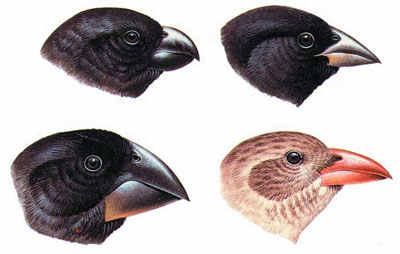 |
| The finches with varying beaks that Darwin saw on the Galapagos Islands—and which he thought constituted evidence for his theory—are in fact examples of variation and represent no evidence for the claim of the evolution of species. |
But this variation in finches has nothing to do with the formation of new species, as evolutionists maintain. The phenomenon consists of new variations within a species emerging through different gene combinations within the entire finch gene pool. The species is still the same species, and there is no question of any new genes—in other words, any new information—being added to the species’ gene pool.
To give an analogy of how evolutionists distort this evident truth on the genetic variation in finches for their own advantage, pick up a pack of playing cards and shuffle it a few times. No new or different cards will ever emerge. All that happens is that the order of the cards changes.
The variation within finches is exactly the same. No new gene is added to the these birds’ gene pool, and the finches newer turn into another species of bird. They merely exhibit variation within themselves. Many living things in nature display even extensive variations, but none of them is evidence for evolution.
Five-digit homology
Just about every book about evolution points to the hand and foot structure of tetrapods —that is, land-dwelling vertebrates—as an example of homology. Tetrapods have five digits on their front and rear feet. Even if these do not always fully resemble fingers or toes, these creatures are still regarded as pentadactyl (having five digits) because of their bone structure.
The hands and feet of a frog, a lizard, a squirrel or a monkey are all of this kind. Even the bone structures of birds and bats agree with this basic design. Therefore, evolutionists claim that all these life forms are evolved from a single common ancestor and for long, they regarded the phenomenon of pentadactylism as evidence of this. In our own time, however, it was realized that this claim actually lacked any scientific validity.
Even evolutionists admit that pentadactylism is a characteristic found in different living groups among which they cannot construct any evolutionary relationship. For example, in two separate articles published in 1991 and 1996, the evolutionist biologist M. Coates states that the phenomenon of pentadactylism emerged on two separate occasions, independently of one another.164 According to Coates, a pentadactyl structure emerged in both Anthracosaurs and in amphibians, quite independently of each other. This finding indicates that pentadactylism cannot represent any evidence for the hypothesis of a common ancestor. (See Common ancestor.)
Another difficulty for the evolutionists is that these vertebrates have five digits on both their front and hind feet. Yet nowhere in the evolutionist literature is it suggested that front and back feet developed from a common ancestor and it is not hypothesized that they then developed independently. Therefore, we would expect front and back feet to have different structures as a result of different random mutations.
Michael Denton has this to say on the subject:
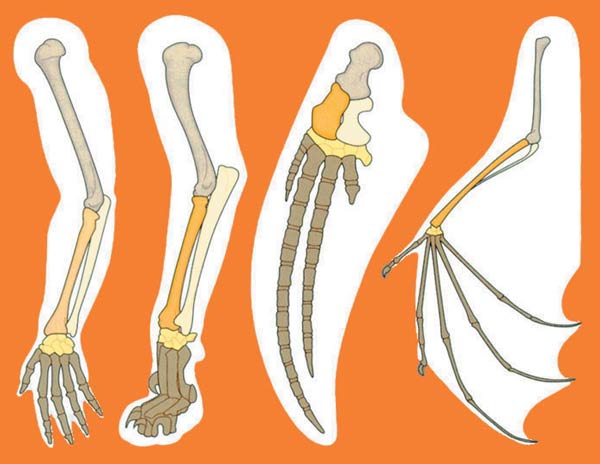 |
| The fact that almost all terrestrial vertebrates have five digits on their hands and feet was for years portrayed by evolutionists as great evidence for Darwinism. However, the latest research has revealed that these bone structures are controlled by very different genes. Thus the five-digit homology hypothesis has now collapsed. |
[T]he forelimbs of all terrestrial vertebrates are constructed according to the same pentadactyl design, and this is attributed by evolutionary biologists as showing that all have been derived from a common ancestral source. But the hind limbs of all vertebrates also conform to the pentadactyl pattern and are strikingly similar to the forelimbs in bone structure and in their detailed embryological development. Yet no evolutionist claims that the hind limb evolved from the forelimb, or that hind limbs and forelimbs evolved from a common source... Invariably, as biological knowledge has grown, common genealogy as an explanation for similarity has tended to grow ever more tenuous... Like so much of the other circumstantial “evidence”" for evolution, that drawn from homology is not convincing because it entails too many anomalies, too many counter-instances, far too many phenomena which simply do not fit easily into the orthodox picture. 165
The real blow to the claim of five-digit homology, so long propagated in evolutionist publications, was dealt by molecular biology. The hypothesis collapsed when it was realized that finger structure was controlled by different genes in different species with a pentadactyl digit structure.
The biologist John Randall describes the collapse of the evolutionist thesis regarding pentadactylism:
The older textbooks on evolution make much of the idea of homology, pointing out the obvious resemblances between the skeletons of the limbs of different animals. Thus the ‘pentadactyl’ [five bone] limb pattern is found in the arm of a man, the wing of a bird, and flipper of a whale, and this is held to indicate their common origin. Now, if these various structures were transmitted by the same gene couples, varied from time to time by mutations and acted upon by environmental selection, the theory would make good sense. Unfortunately this is not the case. Homologous organs are now known to be produced by totally different gene complexes in the different species. The concept of homology in terms of similar genes handed on from a common ancestor has broken down. 166
Fliermans, Carl
Indiana University Professor of Microbiology Carl Fliermans, a renowned scientist, carried out research supported by the U.S. Department of Defense on “the neutralization of chemical wastes by bacteria.” At a conference on “The Collapse of the Theory of Evolution: The Fact of Creation” held by the Science Research Foundation on 5 July 1998, he responded to evolutionist claims at the biochemical level:
Modern biochemistry proves that organisms are marvelously designed, and this fact alone proves the existence of the Creator. 167
Flying reptiles
This interesting subclass of reptiles first emerged some 200 million years ago in the Upper Triassic Period and later became extinct. All are reptiles, because they bear fundamental reptilian features: cold-blooded metabolisms (unable to produce their own heat), and bodies covered in scales. However, thanks to their powerful wings, they were able to fly.
Various popular evolutionist publications portray flying reptiles as a paleontological discovery that supports Darwinism—or at least, give such an impression. In fact, however, their origin constitutes a major dilemma for the theory of evolution: The flying reptiles emerge in the fossil record suddenly and fully formed, with no intermediate form between them and terrestrial reptiles. They have perfectly created powerful wings, which no land reptiles possess. Yet no fossil of a half-winged creature has ever been discovered.
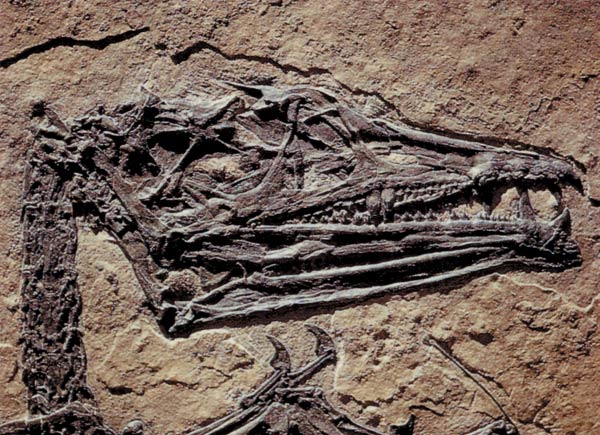 |
| Eudimorphodon, one of the oldest species of flying reptile. This fossilized specimen, found in northern Italy, is around 220 million years old. |
In fact, it is impossible for half-winged creatures ever to have existed. Had such fictitious animals ever lived, they would have been at a disadvantage compared to other species, having lost the use of their front legs, but still being unable to fly. In that case, according to the logic of evolution itself, they would have swiftly gone extinct.
When examined, the wing structure of flying reptiles is seen that as too flawless and sophisticated to be explained in terms of evolution. Flying reptiles have five fingers on their wings, as do other reptiles do on their front limbs. However, the fourth finger is some 20 times longer than the others, and the wing stretches out from it as a membrane. Had terrestrial reptiles actually evolved into flying reptiles, then the fourth finger in question could only have lengthened gradually—and in stages. Not just the fourth finger but all structural wing changes must have come about through mutations, and the entire process must have constituted an advantage for these animals.
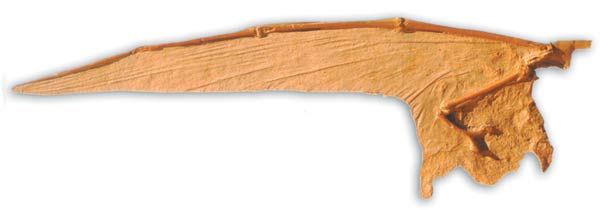 |
| The wing membranes of flying reptiles are attached to a fourth finger some 20 times longer than the other digits. The important feature is that this unique wing structure appears suddenly in the fossil records. There are no intermediate forms to show how the fourth finger developed gradually—in other words, that it extended through evolution. |
Professor Duane T. Gish, a foremost critic of the theory of evolution on the paleontological level, makes this comment:
The very notion that a land reptile could have gradually been converted into a flying reptile is absurd. The incipient, part-way evolved structures, rather than conferring advantages to the intermediate stages, would have been a great disadvantage. For example, evolutionists suppose that, strange as it may seem, mutations occurred that affected only the fourth fingers a little bit at a time. Of course, other random mutations occurring concurrently, incredible as it may seem, were responsible for the gradual origin of the wing membrane, flight muscles, tendons, nerves, blood vessels, and other structures necessary to form the wings. At some stage, the developing flying reptile would have had about 25 percent wings. This strange creature would never survive, however. What good are 25 percent wings? Obviously the creature could not fly, and he could no longer run. 168
It is impossible to account for the origin of flying reptiles in terms of Darwinist evolutionary mechanisms. Indeed, the fossils make it clear that no such evolution ever took place. All that exists in the fossil record are perfect, flying reptiles, along with land-dwelling reptiles of the kind we are familiar with today.
Robert L. Carroll, an evolutionist himself and one of the most eminent figures in the world of vertebrate paleontology, makes this confession:
. . . all the Triassic pterosaurs were highly specialized for flight . . . They provide … no evidence of earlier stages in the origin of flight. 169
None of the flying reptiles provides any evidence for evolution. However, since for most people the word reptile implies a land-dwelling vertebrate, evolutionist publications seek to lump the pterodactyls in with dinosaurs and write about “reptiles opening and closing their wings.” But in fact, land reptiles and flying reptiles emerged with no evolutionary links between them.
Fluoride testing
One method used to determine the age of fossils is fluoride testing, first tried on a number of ancient fossils in 1949 by Kenneth Oakley of the British Museum’s Paleontology Department. Using this technique, an experiment was performed on the Piltdown Man fossil and showed that the “fossil” jawbone contained no fluoride—thus revealing that it had been in the earth for no more than a few years.
The skull, which contained a small amount of fluoride, however, could have been only a few thousand years old.
Subsequent research conducted on the basis of fluoride testing revealed that the skull was indeed only a few thousand years old. It was also determined that the teeth in the jawbone were those of an orangutan and had been artificially abraded, and that the primitive tools found near the fossil were replicas that had been created using steel tools.170 Detailed analysis by Joseph Weiner definitively revealed the fossil’s fraudulent nature in 1953. The skull was human, but only 500 years old, whereas the jawbone belonged to a newly deceased orangutan! (See Piltdown Man.)
Fossil
This is the name given to the remains or traces of a plant or animal preserved in the Earth’s strata. The word itself is of Latin origin, signifying to dig. Fossils collected from all over the world provide detailed information about the organisms that have lived on Earth since life began.
Under normal conditions, when an animal dies, all traces of it quickly disappear. The body may be removed by scavengers or broken down by micro-organisms, after which no trace of the animal is left. Remains are only preserved under exceptional circumstances.171 For that reason, only a very few organisms are preserved as fossils after they die. The fossilization of any organism generally depends on two conditions being met:
1. Swift burial, so that it is protected against attacks by scavengers,
2. The presence of hard body parts, capable of being fossilized.
The most efficient environment for fossilization is a muddy, clay-rich one. After any organism that falls—or is dragged—into such an environment, the elements around harden, forming a mould. Later, the soft tissues of the organism itself generally disappear, due to decay, but the mould or cast remains. If minerals subsequently fill the hollow, the result is an exact copy of the organism’s outline. If the body parts are replaced with different minerals, this is known as petrifaction. So perfect can this petrifaction sometimes be that anatomical studies can even be carried out on fossilized specimens.172
Fossils may include not only the hard parts of living things such as bones, teeth, and shells, but can even preserve moulds of various organs and even suggest lifestyles. The shape of bones and how muscles were attached to them can tell us an animal’s posture and how it moved. 173
 |
| Ever since Darwin’s theory came to dominate the world of science, paleontology has been based upon that theory. Yet despite this, excavations in many regions of the world have provided results that have refuted the theory rather than supporting it. Fossils show that the different living groups on Earth emerged suddenly with all their particular characteristics—in other words, that they were created. |
Fossil research also enables us to obtain information about extinct animals and plants, and when these particular species lived. However, evolutionists also regard fossils as vital in terms of constructing genetic relationships between living things and indicating similarities in their development. They use fossil remains to prove their claim that living things supposedly developed from one another in stages. However, although some 80% of the fossil records have today been uncovered, they have no evidence to offer, apart from a few fossils that subsequently proved to be fakes or the product of distortion. In fact, the fossils in the layers of the Earth confirm that living things have existed in their perfect forms ever since they were first created. (See Fossil records, below.)
In his 1991 book Beyond Natural Selection, the American paleontologist Robert Wesson describes how the gaps in the fossil records are real and objective:
The gaps in the fossil record are real, however. The absence of a record of any important branching is quite phenomenal. Species are usually static, or nearly so, for long periods, species seldom and genera never show evolution into new species or genera but replacement of one by another, and change is more or less abrupt. 174
Fossil records
Observational biological findings do not support the claim that different living things are descended from a common forebear, and it is paleontology, the study of fossils, which clarifies this fact. Evolution, they say, is a process that took place in the past, and our only scientific source of information about the history of life is fossil findings.
The famous French zoologist Pierre Paul Grassé has this to say:
Naturalists must remember that the process of evolution is revealed only through fossil forms. . . Only paleontology can provide them with the evidence of evolution and reveal its course or mechanisms. 175
According to the theory of evolution, living things are descended from one another. One living species already in existence gradually turned into another, with all species eventually coming into being in this way. According to the theory, this transition took place over hundreds of millions of years and proceeded in stages. That being the case, countless transitional forms should have appeared and persisted over a fairly lengthy time frame. (See Transitional Forms.)
| The Fossil Record Argues Against the Theory of Evolution | |
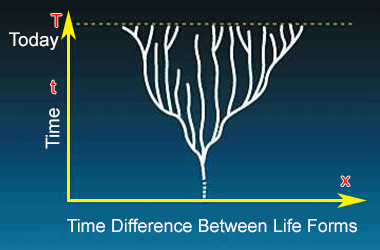 |  |
| T. Today x. Time Difference Between Life Forms | C. Cambrian Period x. Time Difference Between Life Forms |
| The Natural History That Must Have Taken Place According to the Theory of Evolution | The True Natural History Revealed by the Fossil Record |
| The theory of evolution maintains that the different basic living groups (phyla) arose from a single common ancestor and diverged by developing and becoming more complex over the course of eons. The above diagram illustrates this claim: According to Darwinism, life forms must have diverged like the branches of a tree. The fossil record, however, reveals the exact opposite of this. As can be seen in the diagram below, the different living groups on Earth appeared suddenly and with all their different structures completely developed. Some 100 basic living classes (phyla) appeared suddenly in the Cambrian Period. There was no subsequent rise in their number, but actually a decrease, because some phyla became extinct. | |
Indeed, the number of these transitional forms should be even greater than that of the species we know of today. Darwin admitted that this represented an enormous difficulty for his theory in the chapter “Difficulties on Theory” of his book The Origin of Species:
Why, if species have descended from other species by fine gradations, do we not everywhere see innumerable transitional forms? Why is not all nature in confusion, instead of the species being, as we see them, well defined. . . . But, as by this theory innumerable transitional forms must have existed, why do we not find them embedded in countless numbers in the crust of the earth? . . . Why then is not every geological formation and every stratum full of such intermediate links? Geology assuredly does not reveal any such finely graduated organic chain; and this perhaps, is the most obvious and gravest objection which can be urged against my theory. 176
The argument that Darwin proposed 140 years ago in the face of the absence of transitional form fossils—that there may be no transitional forms now, but these may be discovered through later research—is no longer valid. Today’s paleontological data show exceedingly rich fossil records. On the basis of the billions of fossils discovered in various regions of the world, some 250,000 different species have been described. They bear an extraordinary resemblance to the 1.5 million or so species alive today.177 It seems impossible that any transitional forms will be unearthed by new excavations, given the absence of any transitional forms so far in such a rich array of fossil specimens.
T. Neville George, a Glasgow University professor of paleontology, admitted as much years ago:
There is no need to apologize any longer for the poverty of the fossil record. In some ways it has become almost unmanageably rich, and discovery is outpacing integration. . . . The fossil record nevertheless continues to be composed mainly of gaps. 178
Niles Eldredge, the well-known Harvard University paleontologist, refutes Darwin’s claim that the fossil records are inadequate, which is why we are unable to find any transitional forms:
The record jumps, and all the evidence shows that the record is real: The gaps we see [in the fossil record] reflect real events in life's history—not the artifact of a poor fossil record. 179
Darwinists no longer claim the fossil record is not adequate on the account that fossil findings have almost provided all the samples. Main part of the earth is already examined and paleontology has put forward the truth that not “even one intermediary form” exists and living beings which existed for millions of years have “not changed” at all. Evolutionist writer Gordon R. Taylor describes this as follows:
One of the most astonishing features in the fossil record is the way in which new phyla have quietly appeared and carried on without making much impact for a while, and then have suddenly diversified into numerous life forms. This is called by paleontologists “explosive radiation”. (The word is used merely in its basic sense of lines radiating from a point.)180
George Gaylord Simpson, evolutionist paleontologist at the American Museum of Natural History makes the confession:
This is true of all the thirty-two orders of mammals. . . The earliest and most primitive known members of every order already have the basic ordinal characters, and in no case is an approximately continuous sequence from one order to another known. In most cases the break is so sharp and the gap so large that the origin of the order is speculative and much disputed.... This regular absence of transitional forms is not confined to mammals, but is an almost universal phenomenon, as has long been noted by paleontologists. It is true of almost all classes of animals, both vertebrate and invertebrate . . . it is true of the classes, and of the major animal phyla, and it is apparently also true of analogous categories of plants. 181
In the journal Science, D.S. Woodroff of California University sets out this grave disappointment suffered by evolutionists:
But fossil species remain unchanged throughout most of their history and the record fails to contain a single example of a significant transition.182
Fox Experiment, the
Amino acids release water molecules as they combine chemically to form proteins. According to this behavior, known as the Le Chatelier’s principle, it is not possible for a reaction that gives off water (a so-called condensation reaction) to take place in an environment containing water. (See Le Chatelier’s Principle, the.) Therefore, the oceans—where evolutionists say that life began—are definitely unlikely, unsuitable places for amino acids to combine and produce proteins.
Given this “water problem” that so demolished all their theories, evolutionists began to construct new scenarios. Sydney Fox, the best-known of these researchers, came up with an interesting theory to resolve the difficulty. He theorized that immediately after the first amino acids had formed in the primitive ocean, they must have been splashed onto the rocks by the side of a volcano. The water in the mixture containing the amino acids must then have evaporated due to the high temperature in the rocks. In this way, amino acids could have distilled and combined—to give rise to proteins.
But his complicated account pleased nobody. Amino acids could not have exhibited a resistance to heat of the kind that Fox proposed. Research clearly showed that amino acids were destroyed at higher temperatures. Even so, Fox refused to abandon his claim.
He combined purified amino acids by heating them in a dry environment in the laboratory under very special conditions. The amino acids were duly combined, but he still obtained no proteins. . What he did obtain were simple, disordered amino-acid sequences, bound to one another in a random manner, that were far from resembling the proteins of any living thing. Moreover, had Fox kept the amino acids at the same temperature, the useless links that did emerge would have immediately broken down again.183
Another point that makes his experiment meaningless is that Fox used pure amino acids from living organisms, rather than those obtained in the Miller Experiment. In fact, however, the experiment, claimed to be an extension of the Miller Experiment, should have continued from the conclusion of that experiment. Yet neither Fox nor any other researcher used the useless amino acids that Miller produced. 184
This experiment of Fox’s was not received all that positively by evolutionist circles because it was obvious that the amino acid chains (proteinoids) he obtained were not only meaningless, but could not have emerged under natural conditions. In addition, proteins—the building blocks of life—had still not been obtained. The problem of proteins had still not been solved.
| Fox’s “Proteinoids” |
 |
| Under the influence of Miller’s scenario, Stanley Fox combined certain amino acids to form the molecules above, which he called proteinoids. However, these useless amino acid chains had nothing to do with the real proteins that make up living organisms. In fact, all his endeavors confirmed that life cannot be created in the laboratory, let alone come into being by chance. |
An article published in Chemical Engineering News, a science magazine in the 1970s, said this about the experiment conducted by Fox:
Sydney Fox and the other researchers managed to unite the amino acids in the shape of "proteinoids" by using very special heating techniques under conditions which in fact did not exist at all in the primordial stages of Earth. Also, they are not at all similar to the very regular proteins present in living things. They are nothing but useless, irregular chemical stains. It was explained that even if such molecules had formed in the early ages, they would definitely be destroyed. 185
The proteinoids that Fox obtained were certainly far from being true proteins in terms of structure and function. There were as different from proteins as a complex technological device is from a heap of scrap metal.
Furthermore, these irregular collections of amino acids had no chance of surviving in the primitive atmosphere. Under the conditions of that time, destructive chemical and physical effects produced by the intense ultraviolet rays reaching the Earth and by uncontrolled natural conditions would have broken down these proteinoids and made it impossible for them to survive. Because of the Le Chatelier’s principle, there can be no question of these amino acids being underwater where ultraviolet rays could not reach them. In the light of all these facts, the idea that proteinoid molecules represented the beginning of life increasingly lost all credibility among scientists.
 |
| Sydney Fox |
Fox, Sydney
Sydney Fox maintained that proteins, the building blocks of life, had formed by chance from amino acids and carried out an experiment in an attempt to demonstrate this. (See Fox Experiment, the.)
Under the influence of Miller’s scenario, Fox combined various amino acids and produced molecules he named “proteinoids”. However, these functionless amino acid chains had nothing to do with the actual proteins that compose living things. In fact, all of Fox’s endeavors documented that life could not be produced in the laboratory, let alone come into being by chance.
Fruit flies
All evolutionist efforts to establish beneficial mutations have ended in failure. In order to reverse this pattern, evolutionists have for decades been carrying out experiments on fruit flies, which reproduce very quickly and which can easily be subjected to mutations. Scientists have encouraged these insects to undergo all kinds of mutations, a great many times. However, not one single useful mutation has ever been observed.
The evolutionist geneticist Gordon R. Taylor describes these evolutionists’ pointless persistence:
It is a striking, but not much mentioned fact that, though geneticists have been breeding fruit flies for sixty years or more in labs all round the world—flies which produce a new generation every eleven days—they have never yet seen the emergence of a new species or even a new enzyme.186
 | |
| A. Normal | B. Mutant |
| Ever since the beginning of the last century, evolutionist biologists have exposed flies to mutations and looked for examples of beneficial ones. However, all that has ever been obtained are sick, deformed and imperfect flies. The picture shows a normal fly’s head and another, belonging to a fruit fly subjected to mutation, with legs emerging from it. | |
Another researcher, Michael Pitman, expresses the failure of the experiments on fruit flies:
. . . geneticists have subjected generations of fruit flies to extreme conditions of heat, cold, light, dark, and treatment by chemicals and radiation. All sorts of mutations, practically all trivial or positively deleterious, have been produced. Man-made evolution? Not really: Few of the geneticists' monsters could have survived outside the bottles they were bred in. In practice mutants die, are sterile, or tend to revert to the wild type. 187
In short, like all other living things, fruit flies possess specially created genetic information. The slightest alteration in that information only leads to harm.
 |
Futuyma, Douglas
In his 1986 book Evolutionary Biology, Douglas Futuyma maintained that natural selection was an evolutionary mechanism. The example Futuyma’s book cited was that of the color of a moth population turning darker in Britain during the Industrial Revolution—one of the best known such examples. (See Industrial-Revolution moths, the.) However, he admitted, “Organisms either appeared on the earth fully developed, or they did not. If not, then they must have developed from pre-existing species by some process of modification. If they did appear in a fully developed state, they must indeed have been created by some omnipotent intelligence.” 188
In addition, Futuyma—one of the best-known exponents of the theory of evolution in our time—indicates the true reason for the importance of the theory: “Together with Marx's materialist theory of history and society. . . Darwin hewed the final planks of the platform of mechanism and materialism.” 189
Footnotes
160.Pierre P. Grassé, Evolution of Living Organisms, p. 103. 

162.Ann Gibbons, “Plucking the Feathered Dinosaur,” Science, Vol. 278, no. 5341,14. November 1997, pp.1229–1230. 
163.Pat Shipman, “"Birds Do It. . . Did Dinosaurs?,” New Scientist, p. 28. 
164.Coates M. 1991. New palaeontological contributions to limb ontogeny and phylogeny. In: J. R. Hinchcliffe (ed.) Developmental Patterning of the Vertebrate Limb 325-337. New York: Plenum Press; Coates M. I. 1996. “The Devonian tetrapod Acanthostega gunnari Jarvik: postcranial anatomy, basal tetrapod interrelationships and patterns of skeletal evolution,”, Transactions of the Royal Society of Edinburgh 87, pp. 363-421. 
165.Michael Denton, Evolution: A Theory in Crisis, pp. 151, 154. 
166.John Randall, quoted in William Fix’s The Bone Peddlers: Selling Evolution, New York: Macmillan Publishing Co., 1984, p. 189. 
167.http://www.evolutiondeceit.com/conferences. php. 
168.Duane T. Gish, Evolution: The Fossils Still Say No, ICR, San Diego, 1998, p. 103. 
169.Robert L. Carroll, Vertebrate Paleontology and Evolution. p. 336. 
170.“Piltdown,” Meydan Larousse, Vol. 10, p. 133. 
171.Bilim ve Yaflam Ansiklopedisi, Istanbul: Geliflim Publishing, 1976, p. 4. 
172.Prof. Dr. Ali Demirsoy, Yaflam›n Temel Kurallar›, Genel Biyoloji/Genel Zooloji, Vol.I, Chapter I0, Ankara, 1993, pp. 629-630. 
174.Robert Wesson, Beyond Natural Selection, Cambridge, MA: MIT Press, 1991, p. 45. 
175.Pierre Grassé, Evolution of Living Organisms, New York: Academic Press, 1977, p. 82. 
176.Charles Darwin, The Origin of Species, pp. 172, 280. 
177.David Day, Vanished Species, New York: Gallery Books, , 1989. 
178.T. N. George, “Fossils in Evolutionary Perspective,” Science Progress, Vol. 48, January 1960, pp. 1, 3. 
179.N. Eldredge and I. Tattersall, The Myths of Human Evolution, New York: Columbia University Press, 1982, p. 59. 
180.Gordon Rattray Taylor, The Great Evolution Mystery, Abacus, Sphere Books, London, 1984, p. 82. 
181.George G. Simpson, Tempo and Mode in Evolution, Columbia University Press, New York, 1944, pp. 105, 107. 
182.D.S. Woodroff, Science, Vol. 208, 1980, p. 716. 
183.Richard B. Bliss and Gary E. Parker, Origin of Life, California, 1979, p. 25. 
185.S. W. Fox, K. Harada, G. Kramptiz, G. Mueller, “Chemical Origin of Cells,” Chemical Engineering News, June 22, 1970, p. 80. 
186.Gordon R. Taylor, The Great Evolution Mystery, p. 48. 
187.Michael Pitman, Adam and Evolution, London: River Publishing, 1984, p. 70. 
188.Douglas J. Futuyma, Science on Trial, New York: Pantheon Books, 1983, p. 197. 
189.Douglas Futuyma, Evolutionary Biology, 2. b., MA: Sinauer, Sunderland, 1986, p. 4. 
